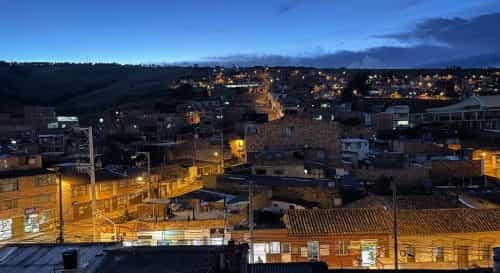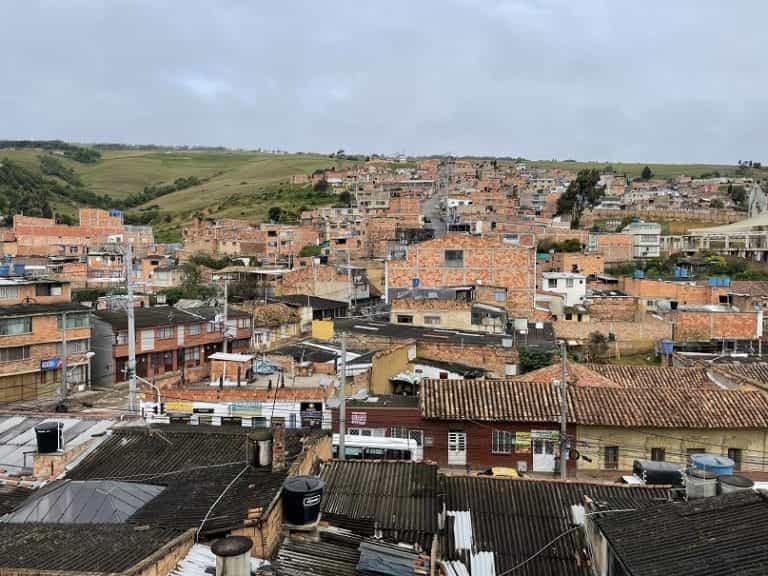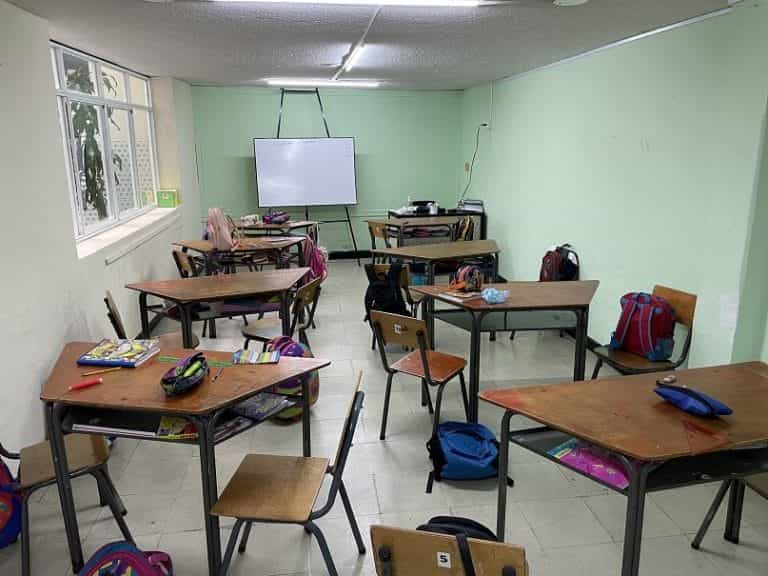Research Update - First Visit to Tunja!

Justin Hauver
Last week I left Abbey in Bogotá, traveled a few hours away to the city of Tunja, and did my first observations at a school that uses the Escuela Nueva model. After a month of reading and preparing, I was excited to finally be entering a school. That’s what I came here to do! Of course, I was also feeling really nervous. I’ve visited around two dozen schools in the US, mostly out of pure curiosity and usually on my own. But this time everything would be in Spanish! And we are still in the middle of a pandemic. Once you step outside your door, it’s sometimes hard to know what is safe and respectful, especially when you enter the nuances of a different language and culture. With these thoughts swirling around, I resolved to take it one step at a time, be extra careful with bioseguridad protocols, and follow the lead of those who opened their doors to me. While I still have some worries, I’m glad that I pushed past my (self) doubts.
Colegio Tunja
The drive from Bogotá to Tunja rises and falls with the undulating greenery of Andean mountains, cow pastures, and fields of crops. Scattered buildings add splashes of red, blue, brown and white. At peaks in the road the cloudy blue sky stretches over the landscape and into the infinite horizon. After two or three hours we pass the monuments at El Puente de Boyocá, where Simón Bolívar’s weary army emerged from the high páramos, took the Spanish army by surprise, and won the battle that freed Neuva Granada. A few minutes down the highway is Tunja.

Tunja is a city spread out over the side of a mountain 2810 meters (9220 feet) above sea level. Two and three story buildings made of reddish-brown bricks hug the contours of the slope. From a distance they seem to be a part of the natural geography. Inside the city, narrow streets zigzag up steep inclines and cut across one another at not quite perpendicular angles. In the soft light of early morning, students, many holding hands with an adult, begin to trickle out of their homes dressed in bright red, heather gray, navy blue, or Colombian yellow school uniform sweaters.
My own walk to Colegio Tunja (a pseudonym) was only a block and a half from my AirBnB apartment. When I arrived, the secretary offered me a tintico (small, strong coffee) and led me to the office of la rectora. I spoke with la rectora about my background, my project, and my tentative observation plans, stressing that I wanted to be respectful of her community and that everything was very flexible. She warmly welcomed me into her school and sent me off to start observing.
Over the course of the week I was able to observe grades 2 through 11 (Colombian schools go to 11th grade), to speak with many of the teachers, to do a recorded interview with la rectora, and to chat casually with many students. Everyone was very friendly and all of the students were VERY curious about me, about the US, and about my impressions of Colombia. My Spanish held up pretty well. I was able to understand everything and only struggled to express myself a few times, like when the political science teacher asked me to share my thoughts on the US withdrawal from Afghanistan and I struggled to find nuanced vocabulary. I even tied another student in a spelling game in Spanish class! I was also glad to see that all of the students and staff wear masks 100% of the time, practice physical distancing, and have reduced class sizes of around 15.
I plan to visit many more times, so this first one was more of an exploratory trip to start building relationships and understanding the broad context of the school. At the end of the week la rectora asked me send her an informal report about my research so far. I’m going to translate and summarize that report here.
Portraiture
As I have explained in earlier blog posts, I am doing a kind of qualitative research called portraiture, which involves a lot of observations and interviews. There are four dimensions or categories that I am interested in exploring as I try to make sense of schools using the Escuela Nueva model:
- Learning, which means the curricula, its rigor, and students’ engagement with it.
- Pedagogy, or how the learning is structured. What are roles of students and teachers, the expectations for each, the power dynamics at play?
- Values/Vision, or what kinds of beliefs about education and people are expressed through words and actions of students and teachers?
- Historical resonance, or how do students and teachers respond to the past and try to enact justice, healing, and hope?
At the end of my research, I hope to write a portrait or a narrative case study of the Colegio Tunja school community that highlights these dimensions and their connections. I’m interested in this kind of research because I think portraits have a special power that allows people to see, feel, and learn deep truths about education. To surface those truths, the methodology recommends a focus on themes that arise through metaphors, symbols, repeated refrains, and rituals. These themes often reveal how people organize their thoughts, actions, and visions of the world.

Metaphors and Symbols
Somos un equipo. We’re a team. From the very first class I observed, third grade history, it was obvious to me that the school culture did not really permit outside observers. The walls started to break down immediately when entire enthusiastically welcomed me into the room with a loud chorus of “Buenos días!” Then, as soon as I sat down, students began asking me who I was and what I was writing in my notebook. In return, they told me their names, explained their work, and showed me their notes. One student in front of me even showed me his Among Us drawings. The message was clear: if you are at this school, then you are part of the team and you participate with others.
This message was amplified in nearly every class throughout the week. Group work was one of the first things that students and teachers mentioned when asked about the school. And indeed every class that observed was humming with the voices of partners or groups discussing the day’s work. Together teachers and students build an understanding using bits and pieces for everyone’s ideas. As la rectora told me, the successful student is one who participates. Translation: the successful researcher is one who participates.
Los cuadernos. The notebooks. In every class I observed, including the primary grades, students were using notebooks. This practice started in a very practical way. Rural schools, where Escuela Nueva’s model first took root, could not afford to give each students a workbook to write in every year. So students had to take notes based on the workbooks or learning guides in blank notebooks. Reading this, an image of students copying notes out of a textbook might come into your mind. But that is not quite how students approach or use their cuadernos.
More than a place to take notes, los cuadernos are a space to construct knowledge. Instead of a simple number two pencil, students have a range of building tools stuffed into pen bags that get progressively more crammed as you move up the grades so that by fifth or sixth grade they are bursting with pens, pencils, and markers of different colors as well as scissors, rulers, glue sticks, and more. With these toolboxes, students construct their own definitions of big concepts, sketch diagrams, draw images, plan out projects, cut up and glue bits of worksheets, and express their own understandings.
Los cuadernos are similar to interactive notebooks, but more fluid and every student learns their basic structure from the primary grades on up through to graduation. Within this basic structure there is a lot of flexibility. Students end up deciding how to organize the bulk of their information and using a variety of headings, colors, and images to do so. Throughout a lesson, the work done in los cuadernos also helps make visible students’ learning so that teachers can quickly check in an guide student understanding.
Repeated Refrains
Innovation and creativity. For the people at Colegio Tunja, it is important that they do not follow the models of past because they just haven’t worked all that well. As such, the school proudly proclaims it’s willingness to innovate, as it did when it adopted the very non-traditional model of Escuela Nueva. Behind this stance is a vision of the future that is intentionally different from the hierarchical framework of society embodied in more traditional (and more common) models of education. Colegio Tunja is trying to cultivate a more collaborative, more just, and more prosperous future through its model of education and through the work it does in classroomsa
Along similar lines of thinking, creativity is seen as something essential to the human experience of liberation. For that reason, inside of the classroom and within the model of Escuela Nueva teachers can modify the official learning guides to better suit their students. Moreover, students can construct and create their own understandings within the structures of los cuadernos.
Inequality and corruption. In many conversations with students, it quickly becomes clear that inequality and corruption in Colombia weigh heavily on their thinking. I could also hear these worries in group conversations, in jokes between students, and in whole class discussions. In one activity, for example, 2 out 3 groups decided that politicians were the least needed member of society because of their propensity towards corruption. In a different class, the students pointed to inequality and corruption as the roots of poverty and discrimination.

he students at Colegio Tunja, however, have a lot of hopes for the future. Several students I spoke to hoped to enter politics to improve the overall situation of the country. Many also pointed specifically to the culture and pedagogy of Colegio Tunja as answers to the problems of corruption and inequality. Working as a team and cultivating a culture of genuine care teaches students how to work in a community, for a community. For many, the school is a space to practice a way of being that could create a better Colombia.
Rituals
Warm-ups and active breaks. Every class that I saw started with some kind of physical and mental warm-up. These included light stretches, a bit of movement, brain teasers, and quick spelling contests. Most classes also had an active break at some point that involved some movement and/or some gamified activity. These practices are not uncommon in other schools, though they are usually not quite so universal. In any case, I think they show a care for the whole student as human beings who periodically need breaks, movement, and games.
Breaks and lunch. The school day at Colegio Tunja is quite long, starting at 7:30am and ending at 5pm. But between classes, students have a 30 minute break in the morning and another in the afternoon. They also have a full two hours for lunch, during which time many walk home and get some time with family. In other words, school does not dominate the entire school day. Students have time to hang out, eat at leisurely pace, play games with peers, etc. Similar to the warm-ups and active breaks, I think this shows a care for students as full human beings, not one dimensional learning machines.
Upcoming plans
It is nearly impossible to visit Colegio Tunja and not get pulled onto the team. Collaboration is just in the air there. So during my visit I asked the English teacher if she would be open to working together on a project and she very enthusiastically agreed. We are still working out the details, but it will likely involve students working in groups to answer a few questions related to my research. They will then plan out and perform group interviews, all in English.
I’m hoping this will be a kind of win-win-win situation in which the English teacher gets some support from me, I get some interesting data points from students, and students participate in a fun project with a semi-real-world outcome. As I build relationships with the people at Colegio Tunja, reciprocity has been at the forefront of my mind. I have been trying to express this in a myriad of ways, from Thank You cards to collaborations like this one. It’s important to me to try to not just extract something from Colegio Tunja, but to work with the people there.
Beyond the English project, I’d like to get in a few interviews with teachers and students, perhaps over lunch. I also need to make some time to review some of the learning guides to get a better feel for the curriculum they use.
Aside from Colegio Tunja, I am in contact with a woman who helped lead the implementation of Escuela Nueva in a number of rural schools that serve indigenous communities. Unfortunately, I cannot visit those schools due to a rise in violence and safety concerns, but I am excited to do a series of interviews with this woman and to connect with some of the teachers from those schools.
Lastly, I’m waiting to hear back from sites in Barranquilla that use an adaption of the Escuela Nueva model called Learning Circles. These sites serve students with interrupted schooling, usually Colombians displaced by violence or Venezuelan refugees. Once they are ready, I’ll plan a trip. But for now, it’s one step at a time.
Note: All views expressed are my own, they do not represent the Fulbright or any other organization.